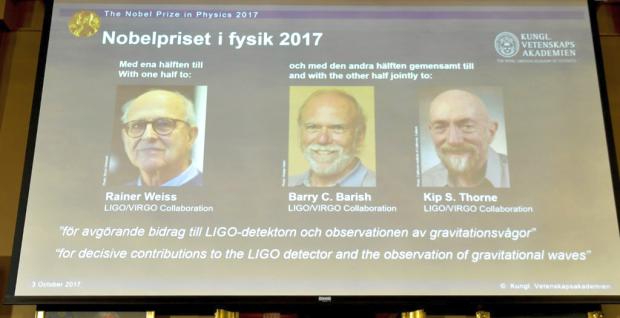
The 2017 Nobel Prize winners in Physics, seen on a projection and are (from left) Rainer Weiss, Barry C. Barrish and Kip S. Thorne, at the Royal Swedish Academy of Sciences in Stockholm Tuesday Oct. 3, 2017. (Photo by JESSICA GOW /TT via AP)
STOCKHOLM — Three US-based scientists won the Nobel Physics Prize on Tuesday for detecting faint ripples flying through the universe – the gravitational waves predicted a century ago by Albert Einstein that provide a new understanding of the universe.
Rainer Weiss of the Massachusetts Institute of Technology and Barry Barish and Kip Thorne of the California Institute of Technology won the 2017 prize for a combination of highly advanced theory and ingenious equipment design, Sweden’s Royal Academy of Sciences announced.
The scientists were key to the first observation of gravitational waves in September 2015. When the discovery was announced several months later, it was a sensation not only among scientists but the general public.
“It’s a win for the human race as a whole. These gravitational waves will be powerful ways for the human race to explore the universe,” said Thorne, speaking by phone with The Associated Press from California.
“I view this more as a thing that recognizes the work of a thousand people,” Weiss told reporters at the announcement news conference.
The prize is “a win for Einstein, and a very big one,” Barish told the AP.
The German-born Weiss was awarded half of the 9-million-kronor ($1.1 million) prize amount and Thorne and Barish will split the other half.
Gravitational waves are extremely faint ripples in the fabric of space and time, generated by some of the most violent events in the universe. The waves detected by the laureates came from the collision of two black holes some 1.3 billion light-years away. A light-year is about 5.88 trillion miles.
Ariel Goobar of the Royal Swedish Academy of Sciences said the winners’ work meant “we can study processes which were completely impossible, out of reach to us in the past.”
“The best comparison is when Galileo discovered the telescope, which allowed us to see that Jupiter had moons. And all of a sudden, we discovered that the universe was much vaster than we used to think about,” Goobar said.
With the technology that the three developed “we may even see entirely new objects that we haven’t even imagined yet,” said Patrick Sutton, an astronomer at Cardiff University in Wales.
The waves were predicted by Einstein a century ago as part of his theory of general relativity. General relativity says that gravity is caused by heavy objects bending space-time, which itself is the four-dimensional way that astronomers see the universe.
Weiss in the 1970s designed a laser-based device that would detect gravitational waves. He, Thorne and Barish “ensured that four decades of effort led to gravitational waves finally being observed,” the Nobel announcement said.
The laser device, called an interferometer, must be both exquisitely precise and extremely stable. “The beam must hit the mirrors precisely. They should hardly shake at all, not even when leaves fall from nearby trees,” according to a Nobel background paper.
The first detection of gravity waves involved two of the devices about 3,000 kilometers (1,900 miles) apart – in Hanford, Washington, and Livingston, Louisiana. The wave first passed the Livingston facility and 7 milliseconds later at Hanford, consistent with the speed of light.
The announcement said Einstein was convinced that gravitational waves could never be measured. The laureates used laser devices “to measure a change thousands of times smaller than an atomic nucleus.”
In a moment of poetry aimed at making the distant and infinitesimal phenomenon understandable to non-experts, the academy announcement said gravitational waves “are always created when a mass accelerates, like when an ice-skater pirouettes or a pair of black holes rotate around each other.”
Professor Alberto Vecchio, from the University of Birmingham’s Institute of Gravitational Wave Astronomy, said this discovery will produce results for decades to come.
“They have taken me, as well as hundreds of my colleagues, through such an intellectually rewarding and recently adrenaline-packed journey that we could not have even remotely imagined,” he said. “The best part is that this is just the beginning of a new roller-coaster exploration of the universe.”
For the past 25 years, the Nobel physics prize has been shared among multiple winners.
Last year’s prize went to three British-born researchers who applied the mathematical discipline of topology to help understand the workings of exotic matter such as superconductors and superfluids.
The 2017 Nobel prizes kicked off Monday with the medicine prize being awarded to three Americans studying circadian rhythms – better known as body clocks: Jeffrey C. Hall, Michael Rosbash and Michael W. Young.
The chemistry prize will be announced Wednesday, the Nobel literature prize on Thursday and the peace prize on Friday. The economics prize, which is not technically a Nobel, will be awarded on Monday.